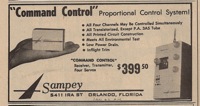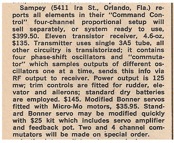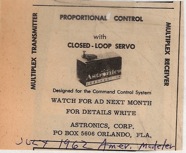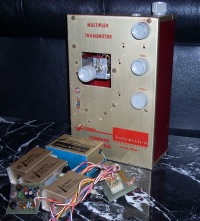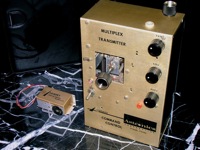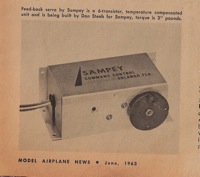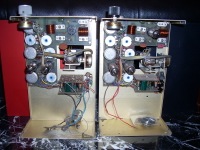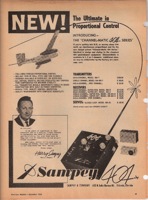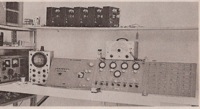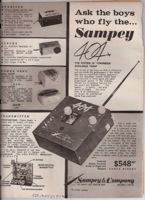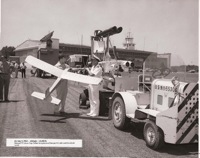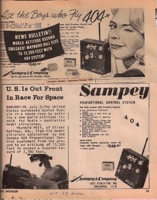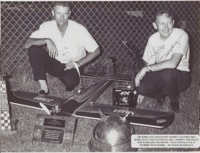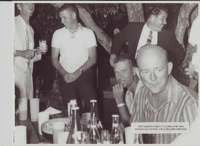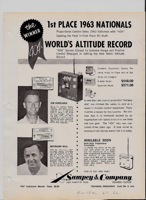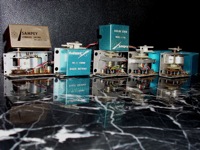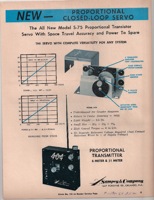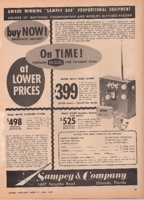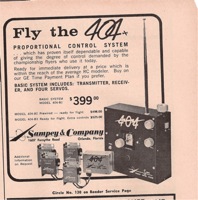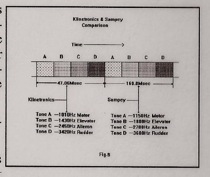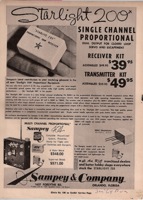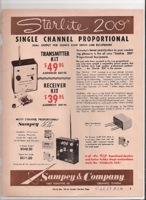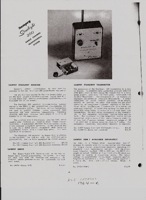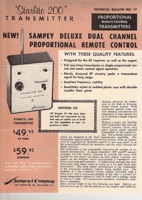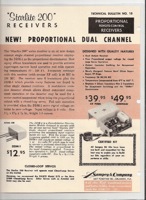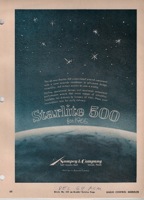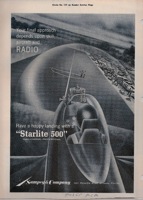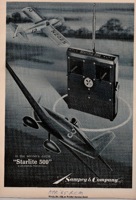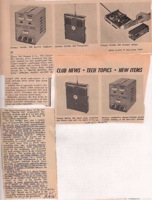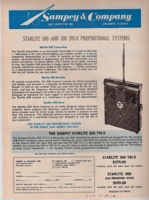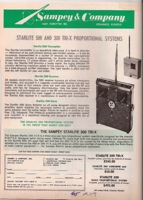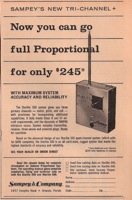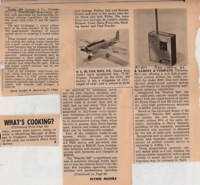Company History:
Sampey
What is it about Sampey radios that make them so special? The Radio Control Hall of Fame® was born of a quest to acquire a single Sampey 404. There was no collection, no museum, no encyclopedia of radio control and, of course, no website. It proved much more difficult than imagined to get one of these pioneering proportional systems, and one thing just lead to another. But the history of Sampey radios begins well before the 404.
It all started with a sunburnt Harry Sampey squinting up at a thundering NASA rocket he helped create, as it shook the earth and headed toward space.
Rocket Scientist
It doesn’t take a rocket scientist to design a proportional control system for model airplanes. But it helps. Harry Sampey was no ordinary rocket scientist. When he was hired by the Martin Company as an engineer on America’s Vanguard rocket he didn’t have an engineering degree. He was not a college graduate at all. Would you believe he didn’t even have a high school diploma? As the Space Race with Russia heated up, America recruited the best and brightest into its rocket program. But a high school drop out? How could he do it?
His former lawyer answered this question for us 47 years later. He hadn’t seen or heard from Sampey in decades. The lawyer was elderly now, and his health had turned for the worse. He wanted to get something off his chest while he still could. Under these circumstances, when one’s credibility is not in question, he told us this:
“Harry Sampey was the smartest man I’ve ever met.”
That’s how Sampey did it. He was no angel. He came up the hard way and rubbed some people the wrong way. But we generally hear even from his critics, an acknowledgement of his intellect. There were two other forces propelling him. He loved flying airplanes (models and real ones) and he had a restless entrepreneurial streak. The latter made it hard for him to be a salary man at a big company when he could strike out on his own chasing the Third Dream of Radio Control, fame and fortune (not necessarily in that order).
First Sampeys
Shortly after transferring to Florida to work on the rocket program Sampey took up two hobbies with his brother Ken – ham radios and flying model airplanes. Sampey was underwhelmed by the crude radio control systems he flew and thought there had to be a better way. Using telemetry and range tracking knowledge from the rocket program, Sampey spent evenings in the utilities room of his Orlando house designing and cobbling together a multiplex proportional system. He didn’t stop until he had achieved the ideal – full house, feedback, non-interacting, quiver-free simultaneous proportional control.
The first Sampey proportionals had no fancy names or graphics. They didn’t even say Sampey on them. The first systems he made were housed in simple aluminum boxes and sold to members of his local radio control club. They were impressed with the shaky but usually successful flights he achieved with his own first system. They particularly enjoyed moving the stick on his transmitter and watching the plane’s control surfaces move proportionally. After years of all-or-nothing, “bang-bang” control systems, they were content to do this over and over again even if the plane was just sitting on the ground; they were mesmerized by the way the control surfaces responded.
Everyone sensed the Third Dream was about to be realized. Something was in the air. Space control proportional was already on the market, but at a price too steep for most. Club members saw Sampey systems as a break-though, short-cut to the promised land of proportional control.
As local demand for his crude, home-built systems grew, Sampey considered going into business. He needed the then-princely sum of $1,000 to launch an RC radio manufacturing venture. His brother Ken agreed to provide the seed money. What happened next epitomizes the perils of early proportional development. Here’s an account, in Sampey’s own words, from his book Wizard of the Outer Lab, Trafford Publishing, 2007:
“Ken had not seen the new radio work in a flying model and I felt he needed to see it since he was investing so much. The following weekend we took a model to an abandoned airfield. I taxied the model out to the runway and took off. After performing a number of circles and loops, I suddenly lost radio control of the model. It went into a number of zigzagged turns, and then dived straight into the ground – smashing the model to little pieces.
In a loud voice, Ken asked “I thought you had the bugs worked out of this radio?”
I answered “ I thought I did, I’ve flown this model and radio a number of times without problem.”
“No way in hell will I invest my money.”
I tried to calm him, “Ken, I’m sure it is something simple.”
“Well, brother, you can count me out. I want my money back.”
“Ken, I have already spent most of your money ordering stuff to start the business.”
“Ok, then you will have to pay me back in payments with interest.” Ken replied with hopes that he would get his money back.”
First Commercial Model
Sampey was undeterred. He wrote to everyone who had expressed an interest in one of his systems and said he would ship in 3 months if they sent deposits. Many did, and Sampey used this funding to augment his brother’s cash and produce his first commercial system – the Command Control. The name was right out of the space program. And so was the labeling on the trim knobs – “yaw”, “roll” and “pitch” instead of rudder, aileron and elevator. The first servos used Bonner mechanics but with Micro Mo motors able to handle the low starting voltages common to analog systems around the neutral zones.
Another local modeler in the advertising field agreed to do advertising layouts and related work in return for one of the systems. American Modeler agreed to run a small ad and wait to be paid until sales came in. Before the ad was ready, American Modeler ran this announcement of the coming, still undefined, system (Nov 61 A.M.):
The next month, American Modeler had these pictures of the coming system exhibiting features, like a triple servo, which were abandoned on the road to the actual production model (Dec 61’ A.M.):
Sampey then worked up a prototype or first production unit good enough to photograph and the first ad was completed. Here’s how that ad looked with its related new product announcement (January, 1962 A.M.):
Imagine how intriguing this ad was back in an era where all the others (except Space Control) were for standard non-proportional radios. To put this in perspective here is the timeline for early proportional.
Early Proportional Timeline
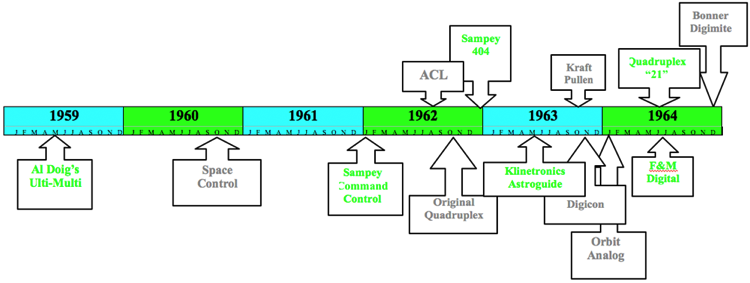
To appear in the January 1962 issue, this ad must have been prepared around October, 1961. Around this time, RC founding father Walt Good became aware of Sampey, maybe by seeing this ad. He invited Sampey to deliver a technical presentation at the 1962 DCRC Symposium. The DCRC was the crucible for radio control development where cutting-edge technology was explained and promoted in a format centered on scholarly papers. By participating, Sampey got a boost for his business and a degree of national recognition.
Here is the first page of Harry Sampey’s presentation to the DCRC (encyclopedia of radio control):
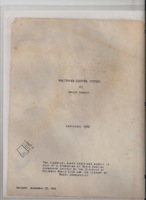 | 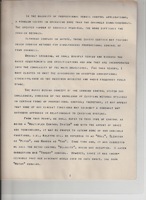 |
Astronics Mystery
What happened next was a complete mystery for years. The July 1962 A.M. ran this ad for a closed-loop servo from “Astronics Corp.” The servo (by Don Steeb) was designed for Sampey’s multiplex Command Control system and the ad says so, but with no mention of Sampey on the servo or in the ad:
On another page in the July 1962 AM it is announced that “Sampey multi-proportional control system has been taken over by Astronics.” This new company offered complete systems with special amplified Don Steeb servos, transmitters, receivers or servos alone or, “for those who wish to experiment with the multiplex system”, individual PC boards, control stick units and cases. It was as if Astronics had acquired Sampey’s assets and was liquidating everything:
The above July, 1962 Astronics Servo ad said to “Watch for Ad Next Month”. There was none. But two months later, “Astronics Corporation” ran this one-third page ad (Sept 62 A.M.):
Note that the complete system is again offered and Sampey’s name is back on every component along with “Astronics”. The transmitter now carries both of the system’s previous names “Multiplex” and “Command Control”.
This ad ran again in the October, 1962 American Modeler along with the following narrative and photographic product announcement. The narrative went into great detail about the system’s new glass tube sealed Hamlin relays:
Here’s an actual Sampey, Astronics, Multiplex, Command Control from our museum. Here's a black-toned version along with a later date servo. The servo looks the same as those pictured in the ad except that the word “ASTRONICS” has been removed, leaving a visible trace of each letter, while the Astronics Corporation nuclear-themed logo remains:
Here is a product review for the subsequent Sampey 404 system. In the picture of the servo, the Astronics logo is gone but you can still make out where the word “ASTRONICS” was erased under the word “Command” (June 63 MAN).
What was all this “Astronics” stuff about anyway? Did Sampey sell his new business voluntarily or otherwise? Was there a new investor, power struggle or change of control? We could only speculate. Then, in January, 2008 Harry Sampey himself shed some light on this subject. After reviewing a draft of this history and his old engineering notebooks he wrote us a letter and explained:
“Astronics was a growing electronic company based in Orlando, Florida. They provided support and several products for companies at Cape Canaveral. Familiar with their operation, I approached the company to have them manufacture my new proportional system. This would allow me to remain with the Martin Company and receive royalties from each sale. By early September of 1962, it appeared that they did not have the required time to promote nor continue to manufacture the product. This resulted in my resigning from Martin and starting my own business in September.”
This clears up the Astronics Mystery, for the most part at least. And the significance of the Astronics Mystery is limited by the fact that it lasted only about five months. In the December 1962 AM, Astronics Corporation disappeared as Sampey’s new flagship system made its splashy arrival.
404
By September of 1962 interest in Harry Sampey’s pioneering proportional system had grown so strong that he was emboldened to take the plunge. He left his steady job at Martin and set sail as the captain of his own ship – Sampey and Company. His lawyer drew up incorporation papers and he rented a 500 square foot manufacturing and office facility in a strip mall four blocks from his house. His advertising friend said he needed a name for his revised systems to be pictured in a major advertising campaign. Sampey came up with “404” since this was his fourth version and it had four channels.
In the December 1962 AM, the Sampey 404 made its debut to the modeling world in this full page advertisement:
Note that this ad pictures the head of the new company (a popular advertising technique years later) and offers bite-sized upgrades from relatively affordable single channel to full house systems (a tactic pioneered by Min-X, among others). The price of a full house system was equivalent to thousands of today’s dollars. The “Channel-matic” add-on approach was designed to get more people to make the initial commitment necessary to start using this costly, unproven new technology.
The add-a-channel philosophy was expanded on in the next ad (Jan/Feb 63 AM):
404 transmitters had open-gimbaled, single stick control like Space Control. Aileron and rudder trim were adjusted by knobs on the front of the case and elevator trim by the recessed knob on the side. The knob on top controlled throttle. Four holes on the front of the case allowed screwdriver access to “master oscillator” adjustment pots inside. These enabled adjustment of servo neutral positions. Turning on the transmitter required two steps. First the on/off switch would be flipped then the red “start” button would be pressed to start the commutator. It was never clear why these functions were not combined in a single switch.
Sampey was particularly proud of the quality of components used and their neat layout on the printed circuit board. The black anodizing on the case was exceptional. 404 transmitters generally look shiny and new after all these years unlike those made by many other companies. The distinctive light grey knobs which appear white in advertisements were used only on early production units. Although these knobs continued to be pictured on all advertisements, a number of different styles were subsequently used.
Here are two actual 404s from out museum – an early model, a later one and a look at what’s inside:
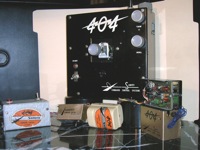 | 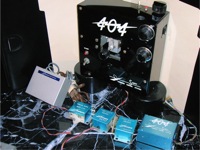 | 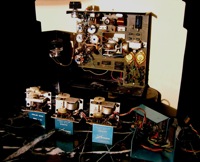 |
Sampey was captain of his own ship but it was a little one at first. He took this picture of his first five transmitters lined up waiting for receivers and servos. He used this for promotional purposes since it depicted commercial production and impressive testing equipment. He showed Don Steeb this picture when he asked him to make servos for the 404s and gave him the first of the five (serial number “1”) to facilitate interoperability. See “First 404”.
Here’s the next 404 advertisement (Apr/May 63 FM):
This was an expensive, full inside cover ad and revealed the internals of the transmitter. Note that one advance was replacement of huge batteries with four standard D cells stepped up by a converter to the 67 ½ volts required for vacuum tubes. The ads pulled in a steady trickle of sales. Then two huge, historic achievements were wrought with 404s and the trickle turned into a torrent.
404 Triumphs
The summer of 63’ brought Harry Sampey two 404 triumphs causing his little company to blast off like one of those NASA rockets he used to work on. On July 5, 1963 Maynard Hill broke the world altitude record with his 404. He almost doubled the previous record held by America’s then arch-enemy, Russia. So high did he fly that he needed elaborate military binoculars and radar tracking to see his model.
Here’s the October, 1963 MAN article on Maynard Hill’s feat:
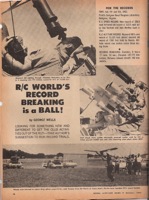 | 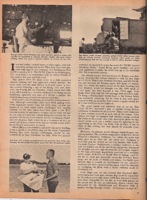 |
Here is the original 8x10 glossy photograph used in this article:
Here are two subsequent Sampey ads capitalizing on this triumph (Sept/Oct 63 AM and Oct 63 RCM):
Later that same month the US Nationals competition would begin. Harry Sampey had met ace pilot Jim Kirkland at the King Orange international that March. Kirkland took first place with his Space Control equipped Beachcomber. Sampey persuaded Kirkland to switch to 404. But Kirkland could never afford to travel to California for the NATS on his Air Force sergeant’s pay. Sales of 404s had only just started to take off and the expense seemed too much for Sampey as well. He was convinced Kirkland was his best chance to place in the top 3 at the Nationals, and knew what this would mean for his business, so he just couldn’t give up. Finally, he found a way to do it, and a dramatic one at that.
A contingent of B-57 bombers was based at Patrick AFB near the cape. Sampey knew some of the officers there and was able to arrange for Jim Kirkland to be flown to the Nationals in California on a B-57 bomber. The pilot said he could do this since the Nationals were at the Los Alimitos military base, the pilot needed to fly a certain number of hours each month anyway and Kirkland was an Air Force sergeant. Sampey was thrilled but asked “how will Jim get his plane and equipment there?” The pilot replied “we can store them in the bomb bay”.
And that’s just what they did. The bomber landed under cover of darkness the night before, the bomb bay doors swung open ominously, and out came the secret weapon to win the Nationals – a Sampey 404. How much do you suppose it cost, in today’s dollars, to fly Jim Kirkland to the Nationals in a jet bomber (counting crew, maintenance, fuel and depreciation)? $250,000? Kirkland, for his part, didn’t disappoint. He proceeded to beat everyone including the legendary Zel Ritchie whose Space Control Kirkland used to win the King Orange four months earlier. It was the first time a full-house proportional system had won the Nationals and a clear turning point in radio control history.
On Top Of The World
It is hard to imagine how big this was for Jim Kirkland and Harry Sampey, personally (fame, fortune, sales promotion, etc.). It’s written clearly in their faces. Here are Jim Kirkland and Harry Sampey on top of the world:
Note, the trophies include the same “one-year-only” globe given to Jack Port a decade earlier. See “First Controlaire Proportional”. Everyone celebrated with a big party at Sampey’s house. Both Kirkland and Sampey were thrown in the swimming pool, fully dressed, in honor of their achievements. Here’s a picture from that party:
Sampey wasted no time turning the summer successes into sales promotion as seen in this advertisement (Nov/Dec 63 G.L.):
The new advertising was buttressed by these glowing feature articles in Radio Control Modeler (Dec 63’) and Grid Leaks (Nov/Dec 63’):
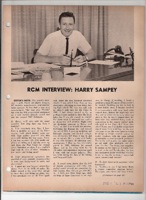 | 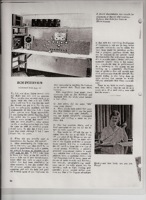 | 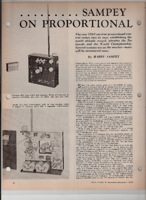 |
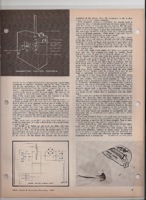 | 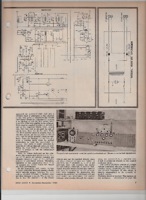 | 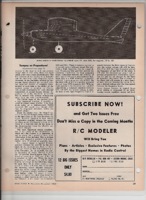 |
After Maynard Hill and Jim Kirkland demonstrated what 404’s could do, orders started streaming in. Sampey bought a larger building on an acre of land about a mile from his Orlando home. There he built several specialized production stations including one to manufacture printed circuit boards. There was room left over for three offices and a research and development area. Years later Sampey would regret not using that R&D area more.
Don Steeb advised Sampey to replace his mimeographed operating instructions with a more polished, professional-looking manual. Here’s how the new manual looked compared to the original instructions (first pages only):
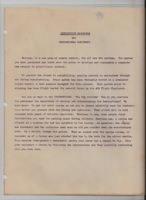 | 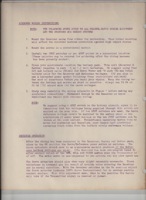 | 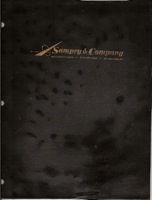 | 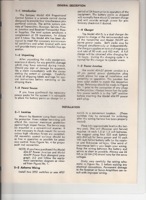 |
To keep up with rising production, Sampey recalls his shop going from three employees to eight, and finally to an all-time high of twenty-two full time employees. In addition to modelers, major corporations bought 404s for such diverse applications as remote radiation testing, automobile design, spacecraft development and military officer training. Even Hollywood called. Eight 404 systems were purchased by Twentieth Century Fox to control models used in filming Von Ryan’s Express starring Frank Sinatra.
New Servos
Around this time, Sampey stopped using Steeb servos. This was because he and Steeb had a falling out or, as Sampey recalls, simply to bring production of this part of the system in-house to increase the overall profit margin. He introduced somewhat smaller, lighter servos in blue anodized cases. We do not know who made these for Sampey or whether they were made in-house. Some of these servos have the word “DASCO” silk-screened on them, others did not. DASCO may have been the manufacturer or designer of the initial blue servos before Sampey took servo production in-house, but this is merely speculation.
Sampey recalls getting help from several engineers at the Martin Company. As his company grew, most of its products were made in-house except the housings. This included printed circuit boards, machine wound coils and other assemblies.
The new servos weighed about 2.5 ounces instead of about 2.75 for the Steeb servos. Like the later model Steeb servos, they had 6 transistors instead of 5. The 6th transistor was said to act as a temperature compensating element, probably to address user complaints about temperature induced servo fluctuation/drift. The new servos used the same Sieman’s Micro Mo motor as Steeb used but they drove a single nylon gear instead of a train of 5 aluminum gears. Some servos held the motor in an aluminum bracket others in a hefty block of aluminum or “pop metal”. The latter is similar to those made by Reynolds Engineering in Winston-Salem, North Carolina and Sampey was known to fly pylon aircraft with members of the local club there; so it is possible Reynolds made the new servos, at least initially, or was one of the influences on its design.
Some of the servos are designated S-75 and others S-100, but it is not clear what the difference was. They were also designated Model 404-CL servos, at least initially, but this is the same designation as the Steeb servos had. Later models had miniature electronics less than half the size and weight of the earlier blue servos. Here are some samples of the blue servos alongside an early Steeb model for comparison:
Here is Sampey’s brochure, “Technical Bulletin No. 15”, announcing the new servos:
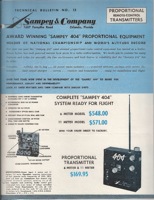 | 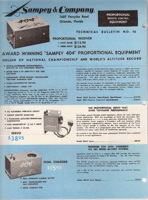 |
Here is their full page ad touting the new servos (Mar/Apr 64’ RCM):
404 B
In the May, 1964 edition of Radio Control Modeler, Sampey & Company announced their new 404B. They proudly assured it was “identical to the model 404 in all respects” except for “a few added features”. Primarily, these features were the elimination of the airborne power converter, enabling 5 flight hours on one charge, and servo enhancements. The 404B was a definite, if limited, improvement in the system. But larger forces including advancing technology, burgeoning competition and 404 reliability problems, were making 404’s harder and harder to sell.
The litmus test of this syndrome was how Sampey’s advertising, like Space Control, before them, grew larger and louder and included measures like financing plans. While Space Control Corporation in its final days enlarged its ads to a full page, Sampey grew its ads to an incredible 2 full pages. Both offered financing, in an attempt to overcome chronic price resistance.
Concurrent with the 2 page ads Sampey ran this single, full page version in Grid Leaks and Model Airplane News:
And here is the remarkable two full page ad in Radio Control Modeler (May 64’ RCM):
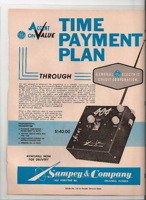 | 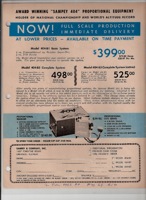 |
The 2 page ad was repeated in the June/July 1964 RCM. This final flourish, like an advertising supernova, was not the end of the historically great 404 system. Its advertising did not go out with a bang, but with a whimper.
Problems
No history of this landmark system can be complete without an examination of its problems and the controversy that swirled around it. After considerable study, we are unable to concur with either of the extreme views voiced about this system – that it was flawless or that it was worthless. The truth, as usual, lies somewhere in the middle.
Sampey 404s, like other pioneering proportional systems, had significant short comings. These included “analog lag” in servo response time, drifting controls/neutral settings especially in response to temperature changes, and “swamping” or control loss at short range. The latter phenomenon earned it the nickname “Swampey 404” in some circles. The instruction manual warned that the servos normally have “slight spasmodic movements” as a result of outside noise entering the receiver. The manual also warned that there could be “momentary loss” of signal/control in flight if the system was installed without adhering to certain pointers. These included running the receiver antenna away from metal objects, and eliminating metal pushrods and metal to metal contacts between servos and control surfaces.
In June, 1965 RCM ran an article by H.E. Woodruff on how to make Sampey 404s more reliable. Woodruff was sharply critical, but allowed that the reliability problems may have been primarily in earlier models, and not necessarily all of them. He recounted a host of problems experienced with his own 404 including complete loss of control with range varying intermittently for no apparent reason. He concluded the receiver was the culprit and 404s could be made highly reliable by replacing half of it with an inexpensive Controlaire reed receiver. Woodruff later ran ads offering to fix 404s for a fee. Here is the article:
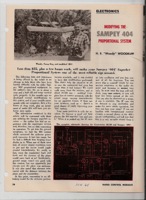 | 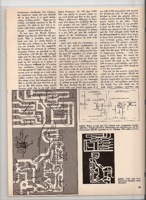 | 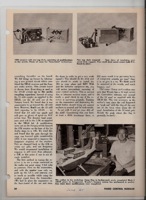 |
We don’t doubt that Sampey 404s had serious problems but we suspect they were exaggerated by many. To this day crashes are conveniently blamed on radios or glitches when the true cause was pilot error, builder error or other factors. Back then there was also the normal “bad-mouthing” of systems by competitors and others with a particular bias. The widely criticized neutral drift of 404s and other analog systems, was sometimes just the differential expansion of airframe vs. pushrod materials (e.g. fiberglass pushrods), and this also occurs to this day. But there are two larger, objective reasons why we discount the harshest criticisms of the 404: Maynard Hill and Jim Kirkland.
If Sampey 404s were so terrible how could it have been possible for Maynard Hill to set multiple world records including altitude (range) and duration, and how could Jim Kirkland have won the Nationals and other major contests with a 404 when the winner’s margin was usually just a few points (which could be lost with even small errors)?
Additional Technical Information
By: Carl Schwab
The Sampey 404 System was a contemporary of Space Control. It used TDMA and FDMA. Throughout its life its design was continuously modified. The late Jim Kirkland flew the Sampey very effectively in competition. He is said to have stressed, “keeping ahead of the plane and system”. Known facts are;
- It was available with a transistorized super regen detector or a superhet. Superhet was on 27Mhz spots and super regen on 6 meters. In either case sensitivity (range) was a problem.
- It used Don Steeb Atlas servos or was provided with Sampey’s own servo. Customers often commented about servo slowness.
- Temperature sensitivity was a problem; trims could drift terribly, even during a flight.
- The transmitter was BIG, 12”H x 10”W x 4”D, heavy and painted black.
- It used a 3-axis stick.
- Receiver was large and heavy; it carried 8 toroidal coils for discriminators.
The transmitter in the RF portion and the tone generator were vacuum tubes. Although quite heavy, in part, because of the complement of 4 AH nicad batteries, its RF output was marginal. Reliability and range were marginal; swamping was a frequent complaint. As usual for hybrid transmitters (part tube and part transistor) the transmitter battery pack was 4/8Vdc. As was so often the case, success (in terms of sales) of a system at a location (a particular flying site) was dependent on some ONE having success with the system.
The Sampey 404 system was FDMA in that different subcarrier frequencies were used for each command. But it was TDMA in that it sent only one subcarrier at a time. The subcarrier frequency was determined by a single electronic multivibrator circuit used to produce all the frequencies. A ring counter clocked at 25Hz, sequenced the 4 tones for the 4 functions continuously. Because the same tone oscillator had to switch for each frequency, there were pronounced “chirp” effects. See Fig. 9.
Note: Fig. 9 describes both Sampey and Klinetronics systems. The glaring difference, the frame time – Klinetronics ran more than three times faster.
Early versions used reed relays driven by the ring counter outputs; later versions were solid state. The four tones were different so no ring counter equivalent was required in the receiver. The subcarrier discriminator circuit for each channel has to provide Track&Hold since the discriminator had subcarrier input only 25% of the time.
The circuit is discussed elsewhere in more detail. Since only one tone was sent in a time slot there should have been no intermodulation effects. One thing, a bit peculiar, is that the rudder channel was twice the frequency of the elevator channel and it was dependent on the symmetry of the hard limiter to reject second harmonics. This may explain the comment of elevator sometimes interacting with rudder.
After Sampey had the 404 on the market for a while, they introduced the 404B which got rid of the reed switches in the transmitter and the power converter in the airborne units. They then introduced the Starlite 300 or the so-called 3+1 proportional. This was single stick for rudder/elevator and thumb lever for throttle. They sold an accessory card for the Starlite 300 that provided CAR that operated below a set throttle and reverted to aileron/elevator above that setting. They used the Bonner stick assembly. They also introduced the Starlite 500 which was offered in the California 2 stick configuration again using Bonner sticks. These Starlite units, the 500 and the 300 were introduced shortly before Sampey went out of business.
Starlite 200
In January, 1964 Sampey ran a full page ad in RCM for its new Starlite 200 single channel proportional system. The ad was replete with technical jargon about advanced features but what stood out was the price: $39.95 for the receiver; $49.95 for the transmitter, if purchased in kit form. This was no doubt Sampey’s attempt to cover the other end of the RC market. Far greater sales volume was possible in the budget market and they no doubt welcomed some relief from the price resistance encountered by the 404 system.
Here’s how the first ad looked (Jan 64’, RCM):
Here’s the second ad for the Starlite 200 run the following month in Grid Leaks and RCM (Feb 64’ RCM):
Although the total price was considerably more when you added the cost of the servo, batteries and harnesses, it was still affordable for true, closed loop, proportional. The system was designed to use a standard 404 type servo for proportional rudder or ailerons plus an escapement for rudimentary throttle control. The latter was by an omission detector engaged by the transmitter’s motor switch.
The transmitter case was atypical for Sampey. It was a generic off-the-shelf case used by other manufacturers (e.g. Ecktronics, Microtrol) and for other applications (e.g. chargers, field strength meters). All other Sampeys had custom-made cases with above-average quality. This may have been another attempt to keep the system’s price low.
The technical heart of the system was the DDM-1 Demodulation Discriminator Module. These were also offered for sale separately by Ace Radio Control for $12.95 for use by experimenters who wanted to built their own proportional sets. Here are the Starlite 200 new product announcements in Grid Leaks, Model Airplane News and Radio Control Modeler (Jan/Feb 64 G.L., APR 64’ MAN, Feb 64’ RCM):
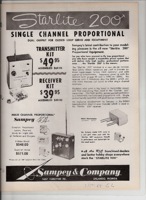 | 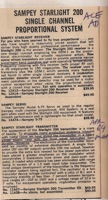 |  |
Here is the ACE catalog page for the Sampey 200 (Cat. 1964-C). Note the receiver description says it “will be offered”, which may mean the system was not available when the catalog went to print, and possibly not even afterwards:
Here is the brochure, “Technical Bulletin No. 17”, which Sampey prepared for the new system:
There is some mystery surrounding the Starlite – 200. Shortly after its announcement the 200 seems to have disappeared. We are aware of no further advertising after the initial January and February, 1964 ads. The line may have been abruptly discontinued. Very few appear to have been sold, perhaps because most flyers by then wanted more than just rudder and engine control. It is even possible that no units sold and the line ended after its initial flush of advertising without going into commercial production. Research continues.
Starlight 500
After the final Sampey 404 ad in November, 1964 that storied system began to fade away. The next month there were no Sampey ads of any kind, just silence. Sampey became concerned that his entire company might fade. He blamed himself for resting on his 404 laurels too long and not continuing aggressive R&D and product development to keep up with advancing technology. He had a very promising new product in the works but it wasn’t ready yet. One reason its introduction was delayed was that (perhaps to make up for its late start), he was determined the new system would have revolutionary advances that set it apart from all the others. These features caused delays and forced its roll-out to be postponed one month at a time.
He decided on a bold strategy. He would bridge the period until the Starlite-500 was ready by running expensive, full page ads for no product. There was simply no product to advertise yet since the system’s function, appearance and pricing were not yet settled. Nothing to advertise except that the Starlite 500 was coming, and it would be great. With these ads Sampey hoped to keep his company’s name before the modeling public and build some anticipation or “buzz” for the new system. He was not about to fade away.
Here is the first of these ads for a system that didn’t exist. The ad was set in outer space, appropriate to Sampey’s background and a system to be named “Starlite”. Note that delivery was announced for January of 1965. This date would ultimately be moved back but Sampey no doubt was certain it could be met at the time the ad was placed. A frustrating inability to keep to product introduction schedules was normal for early proportional manufacturers as even industry leader Phil Kraft lamented.
January of 1965 came and Sampey had no system and not even an ad. The following month Sampey brought his full page ad back to earth with this clever model’s eye view of an approaching RC airplane (Feb 65’ RCM):
This ad was truly eye-catching, memorable and, for model airplane pilots, inspiring. Still, there was no system to show in the ad; nothing to buy, nothing to sell. The ad was repeated in March, 1965.
Finally, in an April, 1965 ad the Starlite 500 appeared. This time the model airplanes were flying circles around the system’s transmitter. It looked strikingly different from any other transmitter and was in fact more unique than it appeared (April, 65’ RCM):
The details on just how exceptional the 500 system was began to come out one month later. Here are the May, 1965 product announcements from RC Modeler and American Modeler (May, 65’ RCM; May/Jun 65’ AM):
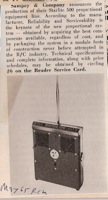 | 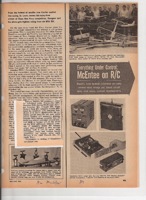 |
Military Motif
Other manufacturers were proud if some of their electronic components were “mil-spec” or up to the level of those specified by the U.S. military. The Starlite 500 system was built, top to bottom, like it was actual military-issue equipment produced in a multimillion-dollar government contract. The futuristic, molded transmitter housing was military olive drab. Both the transmitter and the receiver segregated all electronic components into discreet, color-coded cards or modules, which could be individually unplugged, tested and replaced. The framework of the transmitter was thick solid steel. Its weight, over 3 ¼ pounds, equaled that of a giant Quadruplex 21 transmitter, 2 ½ times its size!
The air vent on the front wasn’t what it appeared to be at all. It was a sealed, electronic voltage meter designed like the badges worn around military nuclear facilities – it would gradually turn red as voltage dropped into the danger zone. The transmitter case had military specification – like printing on its bottom; it opened with special retained screws. Like their military counterparts they allowed emergency (battlefield) access using a knife or coin; no screwdriver was required and no loose fasteners to lose. Finally, bulky test equipment was sold with the system to facilitate module testing.
Like an artist, Sampey signed his Company name in gleaming chrome, hidden deep inside the transmitter. One more small touch setting this system apart from all others. Except for its industry-standard Bonner sticks, the Starlite 500 really was like nothing else.
Here are Grid Leaks and Model Airplane News new product announcements (May/Jun 65’ GL; Jun 65’ MAN):
Note how the MAN review finds practical merit in the modular concept. The 24 hour answering service and rapid replacement procedures might have worked and been very worthwhile in the problem-ridden early days of proportional radios. But we doubt they were ever realized since this amazing system disappeared from model magazines just 2 months later.
Here is the first advertisement for the remarkable Starlite 500 (Jun 65’ RCM):
Note that the ad mentions the Sampey 300 as a lower cost 3-channel alternative with the “same high level” of quality. Actually the 300 was not in the same league as the 500. No system was.
Here is the second ad for the Starlite 500 which, incredibly, was also the final ad (Jul 65’ RCM). Note that this ad pictures the Starlite 300 for the first time, drops its price drastically and drops the Starlite 500 price by over $100
The first 500’s were sold with a mimeographed “Preliminary Instruction Manual” which promised an official manual would follow “on or about May 15, 1965”. Given the short life span of the 500, we were surprised to learn that the proper manual was ever completed. It was, and this was no doubt due, in part, to its combined utility as a manual for both the 500 and 300 systems. Sampey followed up and sent the manual to the early 500 purchasers. Here are the preliminary and official manuals (first pages only):
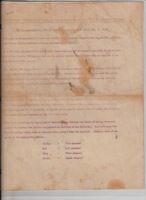 | 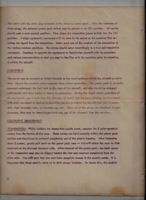 | 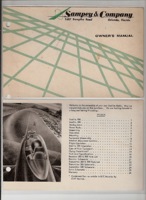 | 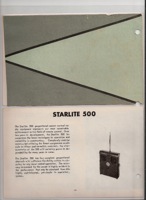 |
Here is an actual Starlite 500 from our museum:
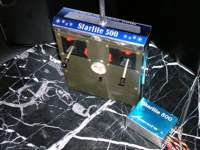 | 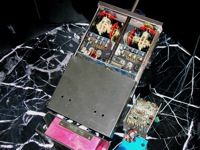 | 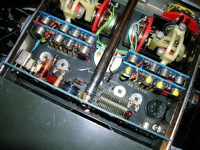 |
Starlite 300
All Sampey advertising ended with the July 1965 Starlite 500 ad until February, 1966 when Model Airplane News ran this small ad for the Sampey 300 which also mentions the Starlite 500 in just ten words with no picture (Feb 66’ MAN):
This ad was repeated in March and April of 1966. This February 1966 trilogy of Sampey 300 ads in Model Airplane news would prove to be the last for the 300 and for all Sampey systems. The ads were accompanied by these new product introduction articles in Grid Leaks and Flying Models (Mar/Apr 66’ GL; Apr/May 66’ FM):
Note that this was a 3+1 system like the Orbit 3+1 introduced earlier in 1965. The Sampey system was analog like the Orbit 3+1, but more modern and about $50 less expensive. A reasonable number of the Sampey 300s sold but not as many as the heavily advertised Orbit system.
The 3+1 designation refers to the possibility of adding an additional (fourth) control function. If, for example, the three channels were used for ailerons, elevator and motor control, the instructions mention three ways to add rudder: A fourth servo wired in parallel (“Y” harness) with aileron; mechanically coupling rudder and aileron or having the fourth servo disconnect via a micro switch whenever the throttle is above a certain setting.
Here’s how an actual Sampey 300 looked, inside and out, from our museum:
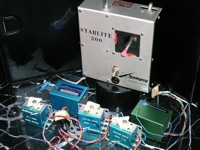 | 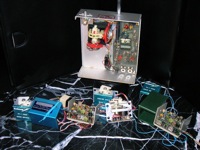 |
Extinction Causes
What happen to the Starlites? How could these major systems disappear from the RC scene so fast?
At this point it appears there were two causes: financial/business problems and technology problems. Like other American manufacturers before him and all but two after him, Sampey’s company got into financial decline, which probably included a bankruptcy and change of control. All these are disruptive events, which curtail vital advertising and hamper success of even the best products.
On top of this Sampey radios were analog systems, which became increasingly disadvantaged as the consensus grew that digital was superior and the wave of the future. Even the impressive Starlite 500 suffered analog symptoms like servo response lag, temperature-induced drift and a practical limit of only four channels. The Starlite 500 was actually more advanced and superior to competitor’s systems in a number of significant respects. But these features proved less important to the RC-buying public than the additional channels, lower prices and crisp, reliable response of the emerging digital systems.
“It’s Over”
The final 3 Sampey ads ran in February, March and April of 1966 but they were purchased in advance, of course, probably at the end of 1965. The first month these ads actually appeared something happened which shook the RC manufacturing world like a meteor striking earth in the Dinosaur days.
Sampey got the word from Jim Kirkland (then flying Orbit, but still a friend). He said something like “Harry, have you seen the latest RC Modeler?” There’s a new California company selling a five channel digital proportional for only $299”. Sampey’s reply was two words:
“It’s over.”
He was right, and more so than he could have known at the time. The new company, PCS, was no fly-by-night peddling shoddy merchandise. It was secretly a division of industry heavyweight Kraft Systems, its radio was actually a Kraft proportional inside and the incredible price was achieved with quality US production.
Sampey moved on to achieve much greater success in other businesses. He was a leading RC pioneer during the golden years of proportional development. He left his mark on the industry and earned an important place in radio control history. His name and radios live on.






